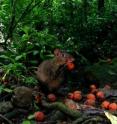Rodent robbers good for tropical trees
Related images
(click to enlarge)
There's no honor among thieves when it comes to rodent robbers -- which turns out to be a good thing for tropical trees that depend on animals to spread their seeds. Results of a yearlong study in Panama, published online in Proceedings of the National Academy of Sciences the week of July 16, suggest that thieving rodents helped the black palm tree survive by taking over the seed-spreading role of the mighty mastodon and other extinct elephant-like creatures that are thought to have eaten these large seeds.
"The question is how this tree managed to survive for 10,000 years if its seed dispersers are extinct," says Roland Kays, a zoologist with North Carolina State University and the North Carolina Museum of Natural Sciences. "There's always been this mystery of how does this tree survive, and now we have a possible answer for it."
The study showed that agoutis, rainforest rodents that hoard seeds like squirrels, repeatedly stole from their neighbors' underground seed caches. All that pilfering moved some black palm seeds far enough from the mother tree to create favorable conditions for germination.
"We knew that these rodents would bury the seeds but we had no idea that there would be this constant digging up of the seed, moving it and burying it, over and over again," says Kays, a member of the Smithsonian Tropical Research Institute team. "As rodents steal the same seed many, many times, it adds up to a long-distance movement of the seed that one animal by itself could have never done."
One seed was buried 36 times before an agouti dug it up and ate it. About 14 percent of the seeds survived until the following year.
The study, funded with a National Science Foundation grant, caught the furry thieves in the act via individual tags on agoutis, video surveillance of seed caches and tiny motion-activated transmitters attached to more than 400 seeds.
Applying such sophisticated animal tracking techniques to the plant world has the potential to improve scientists' understanding of forest ecology and regeneration, Kays says.
"When you think about global climate change and habitats shifting, for a forest to move into new areas, trees need to have their seeds moved into new areas. This opens up a route to study how animals can help trees adjust to climate change through seed dispersal."
Kays, a faculty member with NC State's College of Natural Resources, was part of an international team that included scientists from Ohio State University and institutions in the Netherlands, Belgium, the United Kingdom and Germany.
Source: North Carolina State University
Other sources
- Pilfering rodents help trees survivefrom UPIWed, 18 Jul 2012, 1:30:27 UTC
- Pilfering rodents help trees survivefrom UPIWed, 18 Jul 2012, 0:00:19 UTC
- Thieving rodents explain tree survival mysteryfrom CBSNews - ScienceTue, 17 Jul 2012, 14:30:26 UTC
- Thieving rodents explain tree survival mysteryfrom MSNBC: ScienceMon, 16 Jul 2012, 23:00:41 UTC
- Robbing Rodents Save Tropical Plantfrom Science NOWMon, 16 Jul 2012, 20:30:39 UTC
- Rodent Robbers Good for Tropical Treesfrom Newswise - ScinewsMon, 16 Jul 2012, 20:01:22 UTC
- Thieving Rodents Explain Tree Survival Mysteryfrom Live ScienceMon, 16 Jul 2012, 20:01:05 UTC
- Rodent robbers good for tropical treesfrom Science DailyMon, 16 Jul 2012, 20:00:34 UTC

